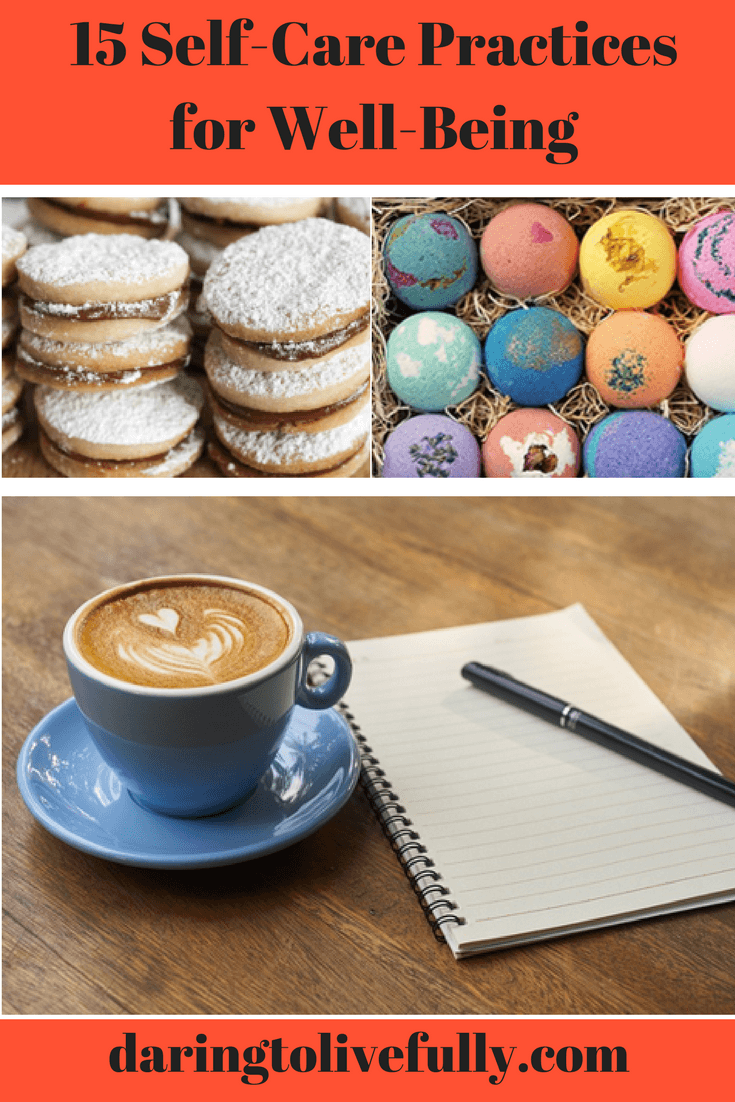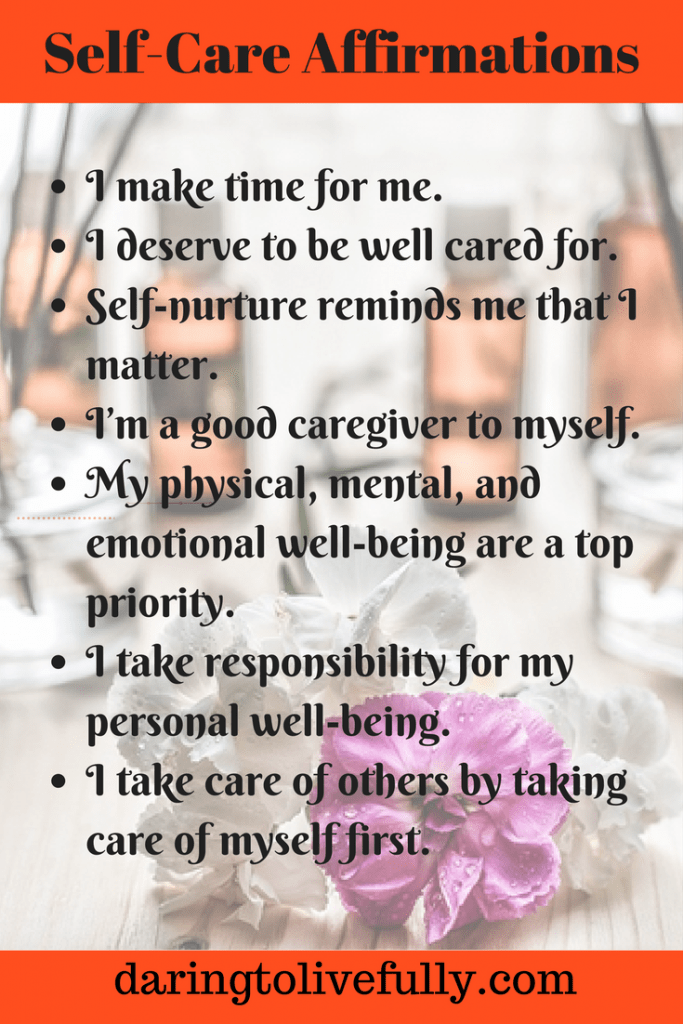
Self-care is care given for you, by you.
If you fall and cut yourself, what do you do? You clean the cut, put some Neosporin on it, and then cover it with a Band Aid. That is, when you suffer bodily injury you act quickly so that you heal properly.
But what about mental injuries? You suffer mental injuries all the time. In fact, almost everyone suffers mental injuries much more often than they suffer physical injuries. Here are some examples:

- You overhear someone say something negative about your looks as they walk by.
- Your boss asks for several corrections on a report you worked hard on.
- You’re rejected by a love interest.
- You fail to meet your monthly sales quota.
- You’re publicly shamed by your professor when he calls on you and you don’t know the answer.
- You get into an argument with a co-worker and she starts spreading lies about you.
At the same time, it’s very likely that you just try to ignore those mental injuries. But if you ignore them, they don’t heal properly. And that leads to all sorts of problems: you become convinced that you can’t succeed; you begin to suffer from low self-esteem; you start to lose perspective; and so on.
Self-care is the mental equivalent of washing a wound, putting an antibiotic ointment on it, and covering it up. It’s important to practice self-care on a regular basis so that your mental wounds heal properly and you can stay mentally healthy. This will make you more self-confident, resilient, and optimistic.
Below you’ll find 15 self-care practices for well-being (for both women and men).
1. Get a Massage.
There’s a shopping center across the street from my building, and they have a kiosk that offers chair massages. Last Friday I got one for the first time ($10 for 15 minutes). I lift weights and the lady got all the knots out of my back–which was heavenly–and I’m thinking of making it a weekly thing.
2. Meditate.
When you meditate you’re taking a break from the rest of the world and you’re redirecting your focus toward yourself. It’s a mental break from the deluge of information that you’re constantly being subjected to. This is indispensable for the brain.
You can also practice self-care with active meditation, which includes yoga, Tai chi, and–my personal favorite– Spring Forest Qigong.
3. Journal.
While keeping a diary is primarily a way of recording the events happening around you, journaling focuses on your interpretation and reaction to those events. It offers you a glimpse into the workings of your mind, and it helps you to deal with whatever is worrying you or making you anxious.
4. Fika.
Fika? What’s that? It’s a Swedish coffee break. But it’s more than that. It’s making sure that you build some downtime into each day. Here’s a quote from the book Fika: The Art of The Swedish Coffee Break, with Recipes for Pastries, Breads, and Other Treats:
“Functioning as both a verb and a noun, the concept of fika is simple. It is the moment that you take a break, often with a cup of coffee, but alternatively with tea, and find a baked good to pair with it. You can do it alone, you can do it with friends. You can do it at home, in a park or at work. But the essential thing is that you do it, that you make time to take a break: that’s what fika is all about.”
Fika is about self-care.
5. Read a Good Book
Reading a good book can give your mind a break from what’s going on around you, so you can come back to the “real world” refreshed. For me, this year, it’s the Russians (Tolstoy, Pushkin, Nabokov, Chekov, Dostoevsky, and so on). For you it might be a book by Elena Ferrante, a suspense thriller, or science fiction.
Choose a genre you enjoy–there’s nothing quite like getting lost in a good book, even if it’s just for a few minutes.
6. Take a Long Shower or Bath.
Water has restorative powers. For millennia, people have sought physical relief, emotional healing, and spiritual renewal by immersing themselves in water. If you choose to take a bath, you can enhance it by adding a bath bomb. Bonus: turn on some ambient sounds and light a candle.
7. Soak Your Feet.
Soaking your feet is one of the most relaxing things you can do. After all, you have over 72,000 nerve endings in your feet, and each one corresponds to a different area of the body. Get a basin and add some hot water (not too hot), Epsom salts, and your favorite essential oils. Then, slide your feet into the water.
When you’re done, dry your feet, get some lotion, and give yourself a foot massage. Bliss!
8. Go Out In Nature.
As I wrote in my post on 8 Reasons Why You Need To Spend More Time in Nature, studies show that spending just 20 minutes in vegetation-rich nature improves vitality. Vitality is defined as emotional strength in the face of internal and external oppositions, and living life with enthusiasm.
I sit outside and put my bare feet on the grass for fifteen minutes, at least three times a week. I find that this direct contact with nature is beneficial to my physical health and psychological well-being.
9. Take a Nap.
In her book Take a Nap! Change Your Life, Dr. Sara Mednick explains that taking a nap does all of the following for you:
- Increases alertness;
- Boosts creativity;
- Reduces stress;
- Improves perception, stamina, motor skills, and accuracy;
- Enhances your sex life;
- Helps you make better decisions;
- Keeps you looking younger;
- Aids in weight loss;
- Reduces the risk of heart attack,
- Elevates your mood; and
- Strengthens memory.
Excuse me. I’m going to take a short nap now. 🙂
10. Listen to Music.
I’ve written about easy ways to bring more music into your life on this blog. When you listen to music, your brain releases the “pleasure chemical” dopamine. This is one of the reasons why music has played such an important role in societies throughout history.
In addition, research shows that people who combine music with a healthy diet and exercise get better results in achieving wellness.
If you’d like, you can dance and sing along.
11. Play.
I have an adult coloring book and a Play-Doh set (Playful Pies). And I take play breaks throughout the day, guilt-free. Playing is fun, it relaxes me, and it keeps my inner kid happy. Practice self-care by playing more.
12. Move.
Moving is vital to our well-being. It’s like taking a happy pill with no side effects. Go rollerblading, go for a bike ride, go for a hike, walk your dog, or find a buddy to join you for a friendly game of tennis.
13. Practice A Hobby .
Whether it’s playing a musical instrument, doodling, or filling out puzzles, practicing a self-absorbing activity that promotes your health is a great way to take good care of yourself. Practicing a hobby isn’t just a way to pass the time, it’s also a way to promote mental and emotional balance.
14. Listen/Watch/Read Something Inspirational.
I’ve already mentioned reading fiction as a method of self-care, but you can also read personal development books for inspiration. YouTube videos, inspirational movies, and motivational podcasts are also a great choice.
Another fantastic option is to peruse the articles on this blog.
15. Use Acupressure.
Acupressure is placing pressure over specific points along the body to improve blood flow, release tension, and enhance or unblock the life-energy, or chi. This release allows energy to flow more freely, promoting relaxation and healing.
The most popular acupressure point is the meaty part of the hand between the thumb and the index finger. Here’s how to locate the specific point.
Another option is to get yourself an acupressure mat and lie on it for twenty minutes or so while you watch TV, meditate, or before you fall asleep.
Bonus — Here are seven self-care affirmations that will foster self-nurturing:

Conclusion
Use the 15 ideas above to create your own list of self-care alternatives for when you need them. Live your best life by taking good care of yourself.





Related Posts:




 Marelisa Fabrega is a lawyer and entrepreneur. She holds a Bachelor of Science in Business Administration from Georgetown University in Washington, D.C., as well as a Juris Doctor from the Georgetown University Law Center. You can learn more about her
Marelisa Fabrega is a lawyer and entrepreneur. She holds a Bachelor of Science in Business Administration from Georgetown University in Washington, D.C., as well as a Juris Doctor from the Georgetown University Law Center. You can learn more about her 





